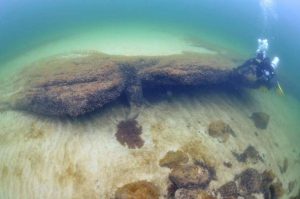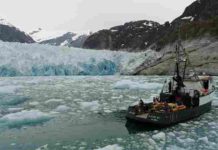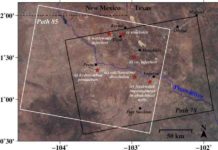
Credit: Arne Sjöström
Six years ago divers discovered the oldest known stationary fish traps in northern Europe off the coast of southern Sweden. Since then, researchers at Lund University in Sweden have uncovered an exceptionally well-preserved Stone Age site. They now believe the location was a lagoon environment where Mesolithic humans lived during parts of the year.
Other spectacular finds include a 9,000 year-old pick axe made out of elk antlers. The discoveries indicate mass fishing and therefore a semi-permanent settlement.
“As geologists, we want to recreate this area and understand how it looked. Was it warm or cold? How did the environment change over time?” says Anton Hansson, PhD student in Quaternary geology at Lund University.
Changes in the sea level have allowed the findings to be preserved deep below the surface of Hanö Bay in the Baltic Sea.
The researchers have drilled into the seabed and radiocarbon dated the core, as well as examined pollen and diatoms. They have also produced a bathymetrical map that reveals depth variations.
“These sites have been known, but only through scattered finds. We now have the technology for more detailed interpretations of the landscape,” says Anton Hansson.
“If you want to fully understand how humans dispersed from Africa, and their way of life, we also have to find all their settlements. Quite a few of these are currently underwater, since the sea level is higher today than during the last glaciation. Humans have always prefered coastal sites,” concludes Hansson.
Reference:
Anton Hansson, Björn Nilsson, Arne Sjöström, Svante Björck, Sofia Holmgren, Hans Linderson, Ola Magnell, Mats Rundgren, Dan Hammarlund. A submerged Mesolithic lagoonal landscape in the Baltic Sea, south-eastern Sweden – Early Holocene environmental reconstruction and shore-level displacement based on a multiproxy approach. Quaternary International, 2016; DOI: 10.1016/j.quaint.2016.07.059
Note: The above post is reprinted from materials provided by Lund University.










